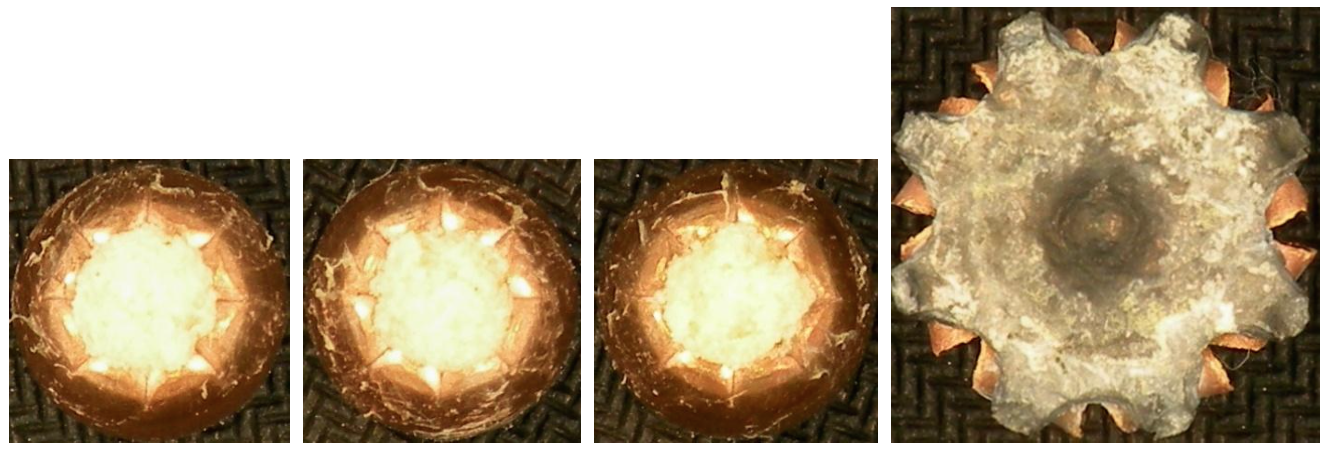Brass Fetcher Ballistic Testing
.45ACP JHP Performance through Bone Simulant Plates with Ballistic Gelatin Backing
Abstract
Six different brands of premium Defensive and Law Enforcement hollowpoints were evaluated in .45ACP. Tested ammunition was Cor-Bon 185gr +P DPX, Cor-Bon 165gr +P Pow’R Ball, Federal 165gr Expanding Full Metal Jacket, PMC 230gr Starfire, Speer 200gr +P Gold Dot and Winchester 230gr SXT.
The ammunition was fired from a Glock 36 handgun, through a bone simulant plate backed by 10% ballistic gelatin blocks. Of the six brands tested, four of the six ammunition types failed to expand in the bone plate/gelatin target. The Cor-Bon 185gr DPX and Federal 165gr EFMJ projectiles performed effectively, by functioning similarly through the bone plate as they did in bare gelatin.
Introduction
Ballistic gelatin is an industry-standard medium used for evaluating the terminal performance of hunting and self-defense ammunition. Gelatin blocks offer many advantages in this role – it is a highly viscous liquid, offering a density close to that of human body fluids and the low-velocity characteristics of muscle tissue. It is a highly consistent material, which makes it very useful for making accurate measurements of damage done to the gelatin by a bullet penetrating soft tissue only.
The critical areas of the body are generally protected in some manner by the presence of bone immediately behind the skin. The large percentage of the vital areas of the chest that are protected by the rib cage and sternum make it desirable to simulate bone and then the soft tissue behind the bone. A priority of this report was in choosing a caliber and ammunition that was relevant to both civilian law enforcement and civilian gun owners. We evaluated several popular .45ACP JHPs from a common CCW firearm – a Glock 36 with 3.8” barrel length.
Bone simulation was effected by placing a bone simulant plate, produced by Synbone AG of Switzerland, in front of blocks of 10% ballistic gelatin (Figure 1). Tested plates were 6mm ( 1⁄4” ) thick and covered by a rubberized ‘skin’ layer. Product number of these plates is PR0114.G. Density for the tested samples came out to be 816 kg/m3 and the failure mode for these was ‘brittle’ failure, similar to bone.
Six different brands of premium Law Enforcement and Defensive hollowpoints were evaluated in .45ACP. Tested ammunition was Cor-Bon 185gr +P DPX, Cor-Bon 165gr +P Pow’R Ball, Federal 165gr Expanding Full Metal Jacket, PMC 230gr Starfire, Speer 200gr +P Gold Dot and Winchester 230gr SXT.
 Figure 1: Bone Simulant Plate and Ballistic Gelatin Block
Figure 1: Bone Simulant Plate and Ballistic Gelatin Block Figure 2: Bone Simulant Plate
Figure 2: Bone Simulant PlateResult
Cor-Bon 185gr +P DPX

Cor-Bon 165gr +P Pow’R Ball

Federal 165gr Expanding Full Metal Jacket

PMC 230gr Starfire

Speer 200gr +P Gold Dot

Winchester 230gr SXT

Relevance to the Tactical Situation

Figure 11: Percentage of Circulatory System shielded by rib cage (Adult Male, 0 degree obliquity)

Figure 12: Percentage of Circulatory System shielded by rib cage (Adult Male, Weaver stance)
We see that there is a good chance that a shot to the upper chest will encounter some bone prior to impacting with soft tissue. Given the 48% odds of engaging an attacker through bone if they have taken a fighting stance prior to the shot, it greatly benefits a shooter of jacketed hollowpoints if the JHP expands after contact with a bone.
Summary
Of the six brands tested, four of the six ammunition types failed to expand in the bone plate/gelatin target. The Cor-Bon 185gr +P DPX and Federal 165gr EFMJ projectiles performed effectively, by functioning similarly through the bone plate as they did in bare gelatin. The wounding mechanism of a jacketed hollowpoint is the crushing of tissue through bullet expansion. Failing this, the lethality of a JHP is oftentimes lower than a full metal jacket which wounds through tumbling. FMJ bullet shapes lend themselves more readily to tumbling than a JHP that failed to expand – though many of the unexpanded JHPs did tumble, it was far too deep into the track to have influenced the lethality of the bullet to any extent.
We recommend using the Cor-Bon 185gr +P DPX and Federal 165gr EFMJ if bullet expansion after a bone hit is a priority. It should be said that the human body consists of many different bones, with shapes other than flat, so these results should be considered as generally indicative of the performance that you can expect in an actual target. In any event, the bullets that failed in these tests will not perform better against living bone.


